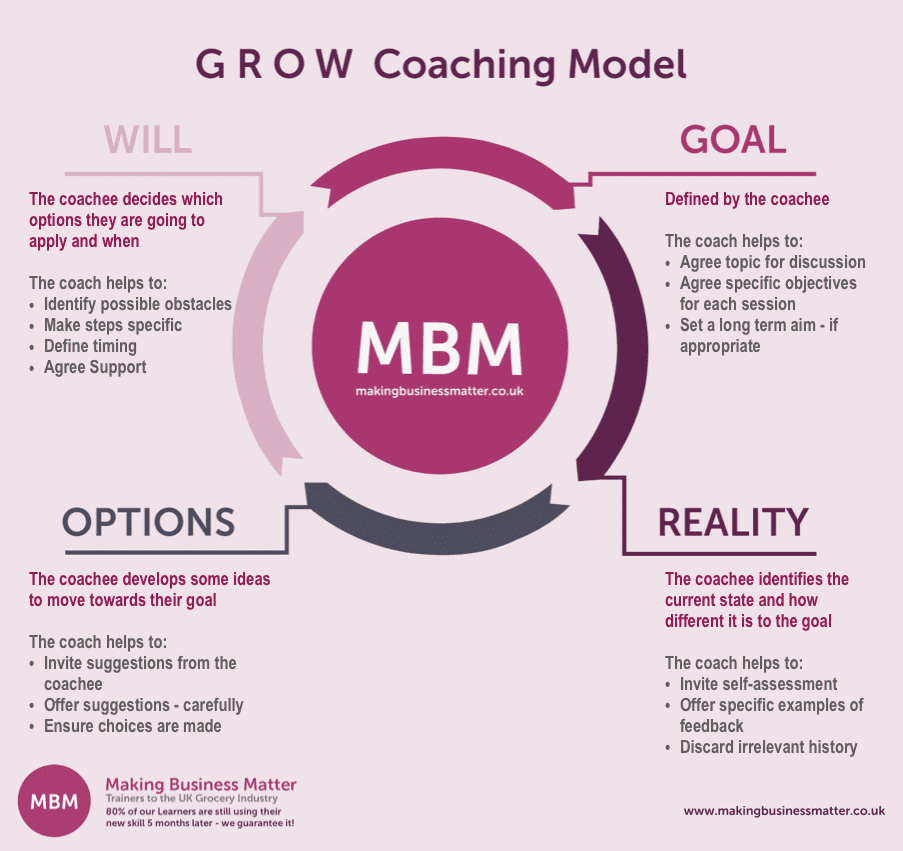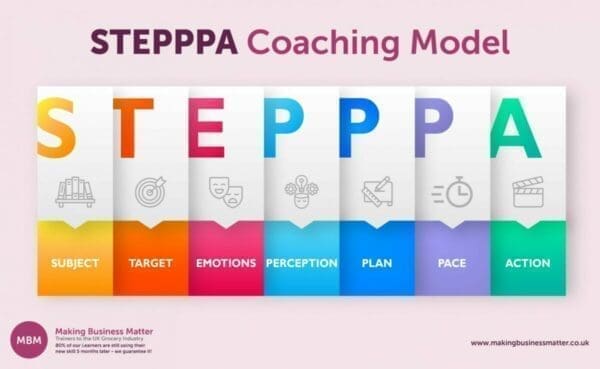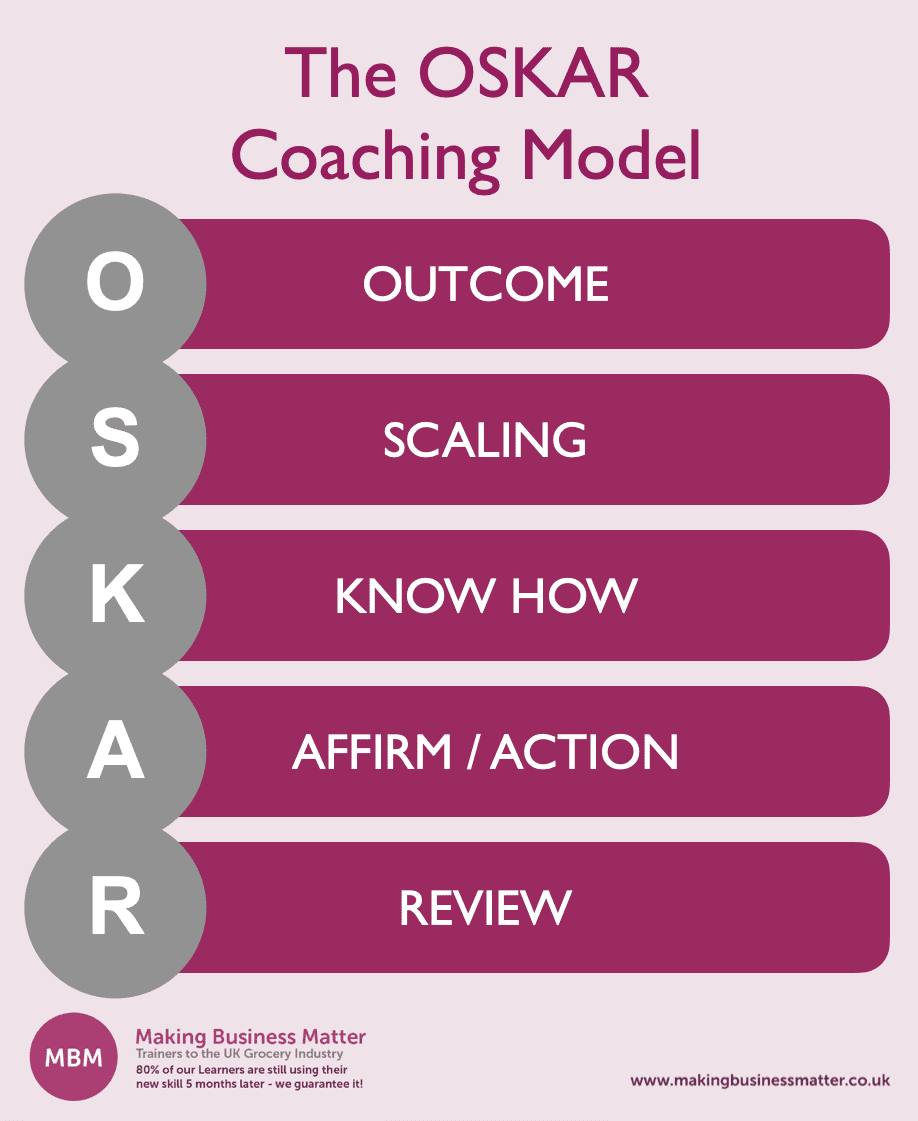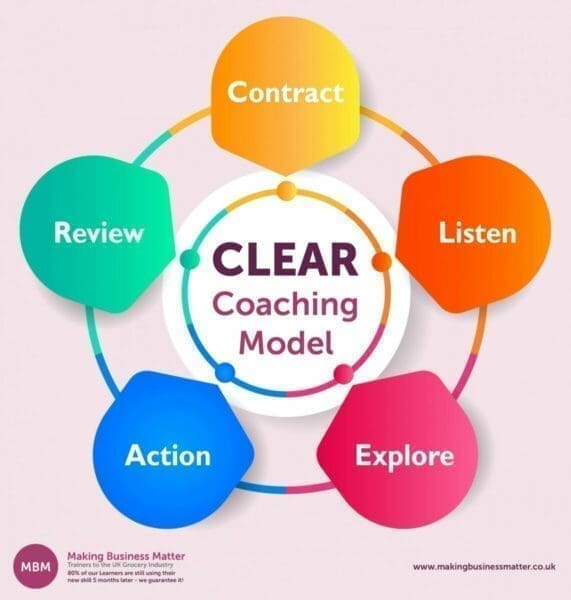Coaching Models that Help You be the Best Version of Yourself and Help Others be the Best Version of Themselves.
In this article, we have taken what we at MBM believe to be the best coaching models & coaching methodologies and will share with you how they work.
This Article Covers:
- GROW: Also known as the G.R.O.W. Coaching Model.
- STEPPA: Also known as the S.T.E.P.P.A. Coaching Model.
- OSKAR: Also known as the O.S.K.A.R. Coaching Model, the OSCAR Coaching Model, and solution-focused coaching.
- CLEAR: Also known as the C.L.E.A.R. Coaching Model.
- Conclusion

1. The GROW Model
Origin: Sir John Whitmore (1992)
The acronym represents these four stages in the coaching conversation:
- Goal
- Reality
- Options
- Wrap Up/Way Forward/Will
Goal
Firstly, at the start of any coaching conversation, you should clearly establish what the coachee wants to achieve. Similar to how those enjoying success set goals for their work and personal life. Subsequently, this gives the session a direction and importantly ensures only meaningful conversation is present.
Reality
Secondly, you must discover where your coachee is in relation to their goal. For example, what progress are they making towards their goal?
Options
Thirdly, this stage of the GROW coaching model is about helping your coachee explore the options available to them. It should be noted that this does not mean them taking their first idea and running with it – evidently, this is flawed. Therefore, as a coach, you must extensively explore all options together because in the world of coaching your coachee needs a solution they are absolutely committed to.
Wrap Up
Finally, we are on the ‘Wrap Up’ stage, the session is coming to a close. Once your coachee has explored different options for moving forward they are in a better position to select the most appropriate and commit to a specific action/s. In addition, it should be noted that as a coach you must ensure your coachee sticks to their commitment and has the right help around them.
Read more about the GROW model and good coaching questions to ask.

2. The STEPPPA Coaching Model
Origin: Dr. Angus McLeod (2003)
- Subject
- Target
- Emotions
- Perception
- Plan
- Pace
- Action
Subject
Firstly, identify the subject of coaching. For example; why does your client need to be coached?
Target
Additionally, as a coach, we must identify what our desired outcome is. It should also be noted that this will be a target your coachee wants to achieve.
Emotions
Furthermore, every decision involves emotions, subsequently embracing these feelings will help guide your choice.
Perception
Moreover, you should try to see your goal from a broader view. Understand the meaning of your purpose, its importance, and what specifically its meaning is for you.
Plan
To achieve your goals, you need to make a plan. Develop a path which can lead you closer to your goals.
Pace
It is like setting time limits and boundaries of achieving each goal. Meaning in how much time you should achieve your target.
Action
Now, it is time to act. Follow your plan step-by-step to achieve your desired outcome.

3. Coaching Models – The OSKAR Model
Origin: Steve de Shazer (1991)
- Outcome
- Scaling
- Know-How
- Affirm & Action
- Review
Outcome
What your coachee wants to achieve – this may be in the long, medium and short term. In addition to this, what they want to achieve from the session itself and how they will know it has been useful to them.
Scaling
Once your coachee has a clear picture of their desired outcome you can then establish where they are already in relation to this.
Know-How
What skills/knowledge/attributes do you currently have that will help you?
When have you done this/something similar before?
What would others say is working for you?
This stage really is about ‘digging for gold’ and plenty of time should be taken to establish the resources your coachee has available to them.
Affirm & Action
Affirming – this is about providing positive reinforcement of what you have heard…reflecting back on positive comments about some of the key strengths and attributes your coachee has revealed e.g. I am impressed with the knowledge you have in this are?’.
Action – this is about helping your coachee determine what small action or actions they will now take.
Review
This final stage of the OSKAR coaching model is for reviewing progress against actions and is therefore most likely to take place at the beginning of the next coaching session. The emphasis is on reviewing the positives:
What is better?
What did you do that made change successful?

4. The CLEAR Coaching Model
Origin: Peter Hawkins (1985)
- Contract
- Listen
- Explore
- Action
- Review
Contract
This stage focuses on establishing desired outcomes – both individual and shared – and revealing how the coach and the process can be tailored to be most valuable to the individual’s needs.
Listen
This stage puts emphasis on the coach having the employee share their reality, their thoughts and feelings. The key aspects here are ‘active listening’ and ‘contract’-focused, catalytic questions that aim to allow the coach and individual to truly understand the situation.
Explore
Once the individual has outlined their current situation, the coach should act slightly more pro-actively to probe further about the depth and context of the situation. This step aims to enable the employee to develop an emotional connection to their behavioural change.
Action
The focus of this stage is to get the employee to commit to the required changes with the intent of internalising their new outlook. The employee should lead the route to action by truly considering each potential option for their next step and its impact on them, personally and professionally.
Review
This stage is as much about following up on employee progress as it is about feedback on the manager’s coaching ability. It is important to ensure that the employee is on track to reaching their goal whilst asking how the coach can improve their style to provide more support.

Concluding the Coaching Frameworks
What is the best coaching model? This is the question we get asked most. In my opinion, the GROW model is the best. This is because we find it easier to understand to use, and gets the best results.
Plus, the GROW coaching model is the most searched of the coaching models. The biggest (most popular) isn’t always the best. In this case, we think it is.

In earnest, if another coaching model is better because you find you get better results, use it. Essentially, results are the aim. How we get there is less relevant.
Action: For even more useful content on coaching, check out our ultimate guide on Coaching Skills.




